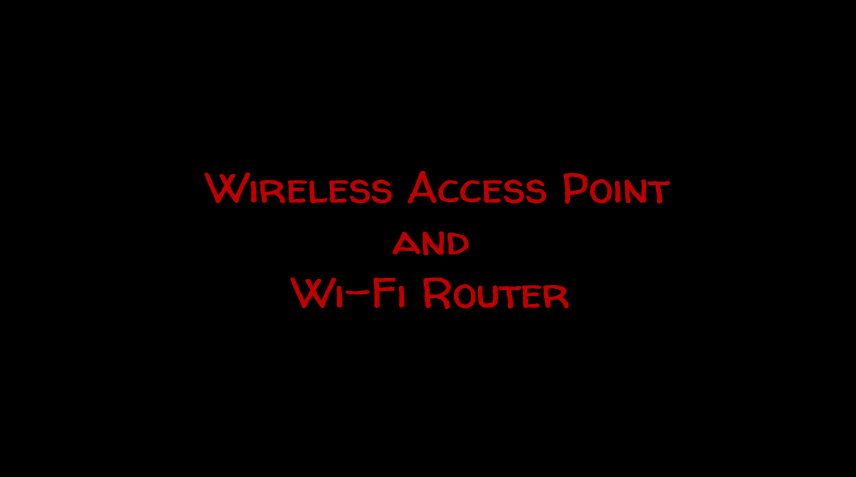Difference Between Wireless Access Point and Wi-Fi Router
Now, many individuals believe that these two devices are interchangeable. However, despite the fact that they appear and function similarly, they are actually distinct from one another. So let's start by discussing a Wi-Fi router. Now, practically everyone in a household with an internet connection has a Wi-Fi router, whether it's a standalone gadget or a component of their modem. Multiple wired and wireless devices can connect to one another to form a local area network thanks to a Wi-Fi router. It will include many network ports and a built-in switch that will allow wired devices to connect to it using Ethernet cables. It will emit a Wi-Fi signal so that wireless devices can connect to it. And to let those devices access to the internet, that Wi-Fi router will next make a direct connection to a modem. Most homes and small offices utilize Wi-Fi routers. So let's imagine we have a regular home where a few desktop computers are wired to the switch embedded into the Wi-Fi router. Additionally, there are wireless connections between the router and our laptops and tablets. Let's now discuss a wireless access point. Between a wired network and wireless devices, a wireless AP transmits data. It essentially functions as a wireless hub that wireless devices connect to in order to access an established wired network.
 |
| Fig 1: Wireless Access Point and Wi-Fi Router |
A wireless AP makes a direct connection to a company's router, which is subsequently immediately connected to a modem. It enables internet connection for wireless devices. Now, medium-sized to big businesses are the main users of wireless access points, and most businesses utilize multiple access points to ensure that the entire facility is covered. We have a medium-sized office, for instance. Additionally, this office has tablets, laptops, and desktop computers. Therefore, Ethernet cables will be used to link the desktop PCs to the organization's router. But this office will make use of wireless access points to allow the wireless laptops and tablets to connect to the network. As a result, the access points will be installed in key locations, and they will all link to the router through Ethernet cables. Once that is complete, they will all simultaneously broadcast a Wi-Fi signal to allow laptops and tablets to wirelessly connect to this network and join it, bringing all desktop PCs and wireless devices under one network. One of the primary reasons larger businesses choose wireless access points rather than Wi-Fi routers is because wireless access points are handled by a single router, which is also true of that one network, which is administered by a single router. In fact, this office might function just as well with Wi-Fi routers instead of wireless APs. However, manageability is a drawback of employing Wi-Fi routers rather than wireless APs. The network administrator would need to get into each Wi-Fi router in order to manage this network and make specific changes. And if there were several Wi-Fi routers, that might be difficult and time-consuming. However, if this office had switched to wireless access points, then this one router would handle all management and configuration updates. It greatly simplifies network management. So, instead of being viewed as several subnets if Wi-Fi routers were used, all wireless devices can be treated as a single subnet.
How
devices can link to them is another difference between them. Wi-Fi routers can
accept connections from both wired and wireless devices, in contrast to
wireless access points, which are only for wireless devices to connect to.
Because a Wi-Fi router will have an Ethernet cable connection switch integrated
into it in addition to a Wi-Fi antenna. An additional distinction is a
firewall. Firewalls are present on Wi-Fi routers but not on wireless access
points. A built-in DHCP service will also be present on Wi-Fi routers. Devices
connecting to it are given IP addresses automatically via a DHCP service.
Therefore, a Wi-Fi router's built-in DHCP service will immediately assign
devices connected to it an IP address. However, because Wireless APs lack a
DHCP function, the devices connecting to them will obtain their IP address from
the company's router. As a result, after a device connects to the wireless AP,
the router will relay the device's IP through the wireless access point.
Additionally, Wi-Fi routers will feature a WAN port, sometimes known as an
internet port. A network cable originating from your modem should be plugged
into a WAN, or internet port. And since a wireless access point lacks a WAN or
internet port, this is what provides your Wi-Fi router with an internet
connection so it can distribute it to other devices. It cannot thus make a
direct connection to a modem. Instead, it must make a direct connection to a
router, and the router is what connects to a modem. And finally, wireless
access points are frequently employed to further extend the wireless signal
already present in a network. In order for remote devices to connect to the
Wi-Fi signal, for instance, if your home required to extend its Wi-Fi signal
further, you can connect a wireless access point to the Wi-Fi router using a
network cable.









0 Comments